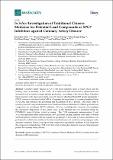In Silico Investigation of Traditional Chinese Medicine for Potential Lead Compounds as SPG7 Inhibitors against Coronary Artery Disease
Author(s)
Chen, Kuen-Bao; Chen, Kuan-Chung; Chang, Ya-Lin; Chang, Kun-Lung; Chang, Pei-Chun; Chang, Tung-Ti; Chen, Yu-Chian; ... Show more Show less
DownloadChen-2016-In Silico Investigat.pdf (14.51Mb)
PUBLISHER_CC
Publisher with Creative Commons License
Creative Commons Attribution
Terms of use
Metadata
Show full item recordAbstract
Coronary artery disease (CAD) is the most common cause of heart attack and the leading cause of mortality in the world. It is associated with mitochondrial dysfunction and increased level of reactive oxygen species production. According to the Ottawa Heart Genomics Study genome-wide association study, a recent research identified that Q688 spastic paraplegia 7 (SPG7) variant is associated with CAD as it bypasses the regulation of tyrosine phosphorylation of AFG3L2 and enhances the processing and maturation of SPG7 protein. This study aims to identify potential compounds isolated from Traditional Chinese Medicines (TCMs) as potential lead compounds for paraplegin (SPG7) inhibitors. For the crystallographic structure of paraplegin, the disordered disposition of key amino acids in the binding site was predicted using the PONDR-Fit protocol before virtual screening. The TCM compounds saussureamine C and 3-(2-carboxyphenyl)-4(3H)-quinazolinone, have potential binding affinities with stable H-bonds and hydrophobic contacts with key residues of paraplegin. A molecular dynamics simulation was performed to validate the stability of the interactions between each candidate and paraplegin under dynamic conditions. Hence, we propose these compounds as potential candidates as lead drug from the compounds isolated from TCM for further study in drug development process with paraplegin protein for coronary artery disease.
Date issued
2016-04Department
Massachusetts Institute of Technology. Computational and Systems Biology Program; Massachusetts Institute of Technology. Department of BiologyJournal
Molecules
Publisher
MDPI AG
Citation
Chen, Kuen-Bao, Kuan-Chung Chen, Ya-Lin Chang, Kun-Lung Chang, Pei-Chun Chang, Tung-Ti Chang, and Yu-Chian Chen. “In Silico Investigation of Traditional Chinese Medicine for Potential Lead Compounds as SPG7 Inhibitors Against Coronary Artery Disease.” Molecules 21, no. 5 (May 5, 2016): 588.
Version: Final published version
ISSN
1420-3049